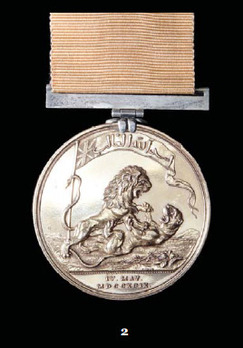Seringapatam Medal, in Gilt
SKU: 02.GBR.0155.102.01
Estimated market value:

Estimated market value:
Attributes
History
The Seringapatam Medal was established by the Honourable East India Company in 1801. It was created to commemorate the capture of Seringapatam on May 4, 1799, and the defeat of Tipu Sultan in the Fourth Anglo-Mysore War (1798-1799).
It was awarded to all 50000 British and Indian troops who served in the campaign, although it was awarded in different compositions to different ranks. Officers of the Honourable East India Company received permission to wear the medal in 1815, and British Officers received permission in 1851.
The Gilt Medal was awarded to 185 recipients including Members of Council, Field Officers, General Staff and additional dignitaries.
The obverse features an Arabic inscription that can be translated to “The Lion of God is Conqueror,” and depicts the British Lion toppling a Bengal tiger, the emblem of the government of Tipu Sultan. The reverse features a Farsi inscription that can be translated to “The Fort of Seringapatam, the Gift of God, 28th day of the month Zikadah, 1213 of the Hegira.”
The Medals were issued unnamed and without a suspension, although it is common to find them either pierced or with a ring added and worn on an orange ribbon. It is also possible to find some medals that have been privately named.

Versions
$2,750-3,000 USD
Silver gilt
Obv: [ARABIC INSCRIPTION] IV. MAY. MDCCXCIX. Rev: [FARSI INSCRIPTION]
48mm
Soho Mint, Birmingham
The engraver's initials "C.H.K." are stamped on the obverse.


Comments
Sign in to comment and reply.


Scroll Top